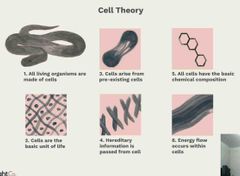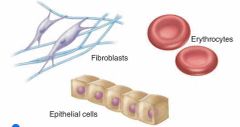![]()
![]()
![]()
Use LEFT and RIGHT arrow keys to navigate between flashcards;
Use UP and DOWN arrow keys to flip the card;
H to show hint;
A reads text to speech;
32 Cards in this Set
- Front
- Back
|
Modern cell theory |

Back (Definition) |
|
|
Cells that connect body parts, form linings, or transport gases |

Back (Definition) |
|
|
Cells that move organs and body parts |

Back (Definition) |
|
|
The English scientist _____________ first observed plant cells with a crude microscope in the late 1600s. Then, in the 1830s two German scientists, __________________ proposed that all living things are composed of cells. German pathologist ____________ extended this idea by con- tending that cells arise only from other cells. |
Robert Hooke Matthias Schleiden and Theodor Schwann, Rudolf Virchow |
|
|
Cells the store nutrients Cells that fight diseases |

Back (Definition) |
|
|
Cell that gathers information and controls body functions |

Back (Definition) |
|
|
Cell of reproduction |

Back (Definition) |
|
|
A human cell has three main parts: |
● The plasma membrane: the outer boundary of the cell which acts as a selectively per- meable barrier. ● The cytoplasm (si′to-plazm): the intracellular fluid packed with organelles, small structures that perform specific cell functions. ● The nucleus (nu′kle-us): an organelle that controls cellular activities. Typically the nucleus lies near the cell’s center. |
|
|
The _______________, a flexible yet sturdy barrier that surrounds and contains the cytoplasm of a cell, is best described by using a structural model called the fluid mosaic model. |
plasma membrane |
|
|
The basic structural framework of the plasma membrane is the ______________, two back-to-back layers made up of three types of lipid molecules—phospholipids, cholesterol, and glycolipids |
lipid bilayer |
|
|
Receptor-mediated endocytosis of LDLs (and other ligands) occurs as follows: |
1 Binding. On the extracellular side of the plasma membrane, an LDL particle that contains cholesterol binds to a specific receptor in the plasma membrane to form a receptor–LDL complex. The receptors are integral membrane proteins that are concentrated in regions of the plasma membrane called clathrin-coated pits. Here, a protein called clathrin attaches to the membrane on its cytoplasmic side. Many clathrin mol- ecules come together, forming a basketlike structure around the receptor–LDL complexes that causes the membrane to invaginate (fold inward). 2 Vesicle formation. The invaginated edges of the membrane around the clathrin-coated pit fuse, and a small piece of the membrane pinches off. The resulting vesicle, known as a clath- rin-coated vesicle, contains the receptor–LDL complexes. 3 Uncoating. Almost immediately after it is formed, the clathrin- coated vesicle loses its clathrin coat to become an uncoated vesicle. Clathrin molecules either return to the inner surface of the plasma membrane or help form coats on other vesicles inside the cell. 4 Fusion with endosome. The uncoated vesicle quickly fuses with a vesicle known as an endosome. Within an endosome, the LDL particles separate from their receptors. 5 Recycling of receptors to plasma membrane. Most of the receptors accumulate in elongated protrusions of the endo- some (the arms of the cross-shaped vesicle at the center of the figure). These pinch off, forming transport vesicles that return the receptors to the plasma membrane. An LDL receptor is returned to the plasma membrane about 10 minutes after it enters a cell. |
|
|
Passive processes |
Diffusion Simple diffusion Facilitated diffusion Osmosis |
|
|
Active processes |
Active transport Primary AT Secondary AT |
|
|
Transport in vesicles |
Endocytosis Receptor-mediated endocytosis Phagocytosis Bulk-phase Endocytosis Exocytosis Transcytosis |
|
|
Movement of substances down a concentration gradient until equilibrium is reached; do not require cellular energy in the form of ATP. |
Passive processes |
|
|
Movement of molecules or ions down a concentration gradient due to their kinetic energy until they reach equilibrium. |
Diffusion |
|
|
Passive movement of a substance down its concentration gradient through the lipid bilayer of the plasma membrane without the help of membrane transport proteins. |
Simple diffusion |
|
|
Passive movement of a substance down its concentration gradient through the lipid bilayer by transmembrane proteins that function as channels or carriers. |
Facilitated diffusion |
|
|
Passive movement of water molecules across a selectively permeable membrane from an area of higher to lower water concentration until equilibrium is reached. |
Osmosis |
|
|
Movement of substances against a concentration gradient; requires cellular energy in the form of ATP. |
Active processes |
|
|
Active process in which a cell expends energy to move a substance across the membrane against its concentration gradient by transmembrane proteins that function as carriers. |
Active transport |
|
|
Active process in which a substance moves across the membrane against its concentration gradient by pumps (carriers) that use energy supplied by hydrolysis of ATP. |
Primary active transport |
|
|
Coupled active transport of two substances across the membrane using energy supplied by a Na or H concentration gradient maintained by primary active transport pumps. Antiporters move Na (or H) and another substance in opposite directions across the membrane; symporters move Na (or H) and another substance in the same direction across the membrane. |
Secondary active transport |
|
|
Active process in which substances move into or out of cells in vesicles that bud from plasma membrane; requires energy supplied by ATP. |
Transport in vesicles |
|
|
Movement of substances into a cell in vesicles. |
Endocytosis |
|
|
Ligand–receptor complexes trigger infolding of a clathrin-coated pit that forms a vesicle containing ligands. |
Receptor-mediated Endocytosis |
|
|
“Cell eating”; movement of a solid particle into a cell after pseudopods engulf it to form a phagosome. |
Phagocytosis |
|
|
“Cell drinking”; movement of extracellular fluid into a cell by infolding of plasma membrane to form a vesicle. |
Pinocytosis or bulk-phase Endocytosis |
|
|
Movement of substances out of a cell in secretory vesicles that fuse with the plasma membrane and release their contents into the extracellular fluid. |
Exocytosis |
|
|
Movement of a substance through a cell as a result of endocytosis on one side and exocytosis on the opposite side. |
Transcytosis |
|
|
The process by which entire worn-out organelles are digested is called ______________. the organelle to be digested is enclosed by a membrane derived from the ER to create a vesicle called an autophagosome (aw-to ̄-FA ̄-go ̄-so ̄m); the vesicle then fuses with a lysosome. In this way, a human liver cell, for example, recycles about half of its cytoplasmic contents every week. |
autophagy (aw-TOF-a-je ̄; auto- self; -phagy eating) |
|
|
Lysosomal enzymes may also destroy the entire cell that con- tains them, a process known as _______________. occurs in some pathological conditions and also is responsible for the tissue deterioration that occurs immediately after death. |
autolysis (aw-TOL-i-sis) |

